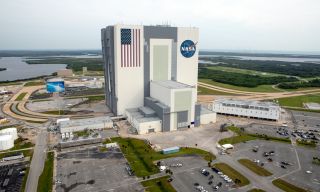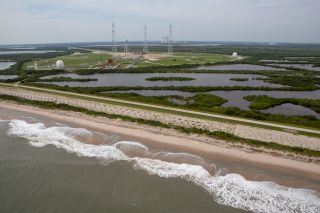Hurricane Dorian continues its march up the Atlantic coastline, grazing North Carolina and Virginia today (Sept. 6) even as NASA’s Kennedy Space Center has finished assessing the storm’s impacts.
The storm hit Florida on Wednesday (Sept. 4). After NASA spent days preparing for the worst-case scenario, the hurricane’s impact was less severe than initial forecasts had suggested it might be. A crew of personnel rode out the storm at launch control to keep an eye on the situation.
Late Thursday night (Sept. 5), NASA confirmed that no flight hardware had been damaged by the storm and that the facility would open as usual today.
Related: Watch Hurricane Dorian in Action in These Gifs by NASA and NOAA

An aerial survey of NASA’s Kennedy Space Center in Florida was conducted after Hurricane Dorian skirted the Space Coast area. on Sept. 3-4, 2019. This image was taken Sept. 5.
(Image credit: Cory Huston/NASA)

Personnel at NASA’s Kennedy Space Center conducted an aerial survey to look for damage after Hurricane Dorian hit.
(Image credit: NASA/Cory Huston)
As the storm has moved up the Atlantic coast, it has stayed slightly farther out to sea than some predictions had suggested it might, somewhat reducing the severity of its impacts. The hurricane has also picked up its pace, a strong contrast to the 24-hour stall that made it so damaging to Grand Bahama Island.
In the current forecast from the National Oceanic and Atmospheric Administration’s (NOAA) National Hurricane Center (NHC), only a few patches of U.S. land in North Carolina, Virginia, Maryland and Massachusetts are subject to hurricane and tropical storm warnings.
Dorian is predicted to pass directly over Nova Scotia with hurricane-force winds on Saturday evening (Sept. 7) and over northern Newfoundland on Sunday (Sept. 8).
If you live along the Atlantic coast, follow the NHC and your local office of the National Weather Service for the latest forecasts.
Email Meghan Bartels at mbartels@space.com or follow her @meghanbartels. Follow us on Twitter @Spacedotcom and on Facebook.






